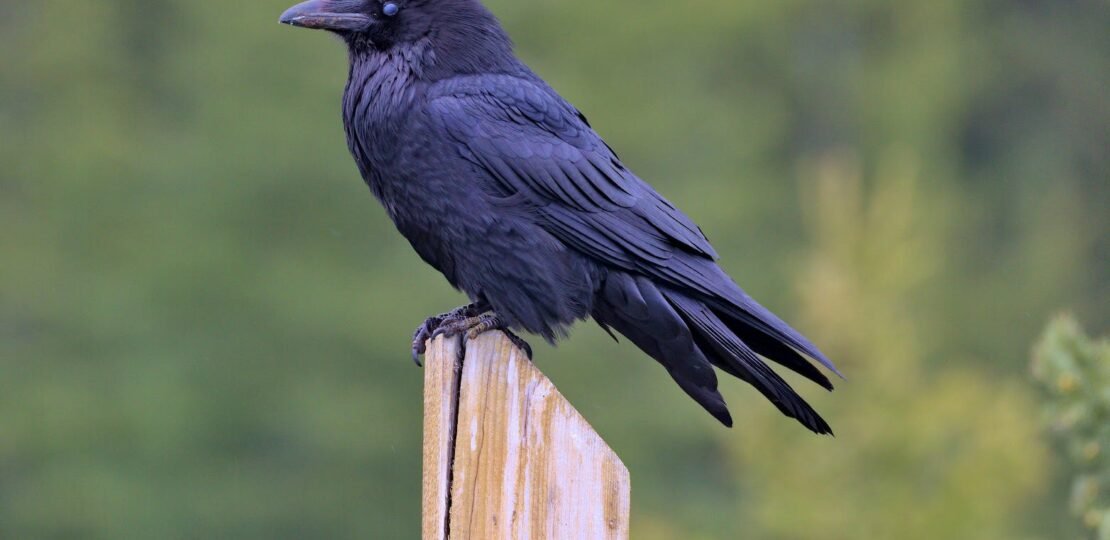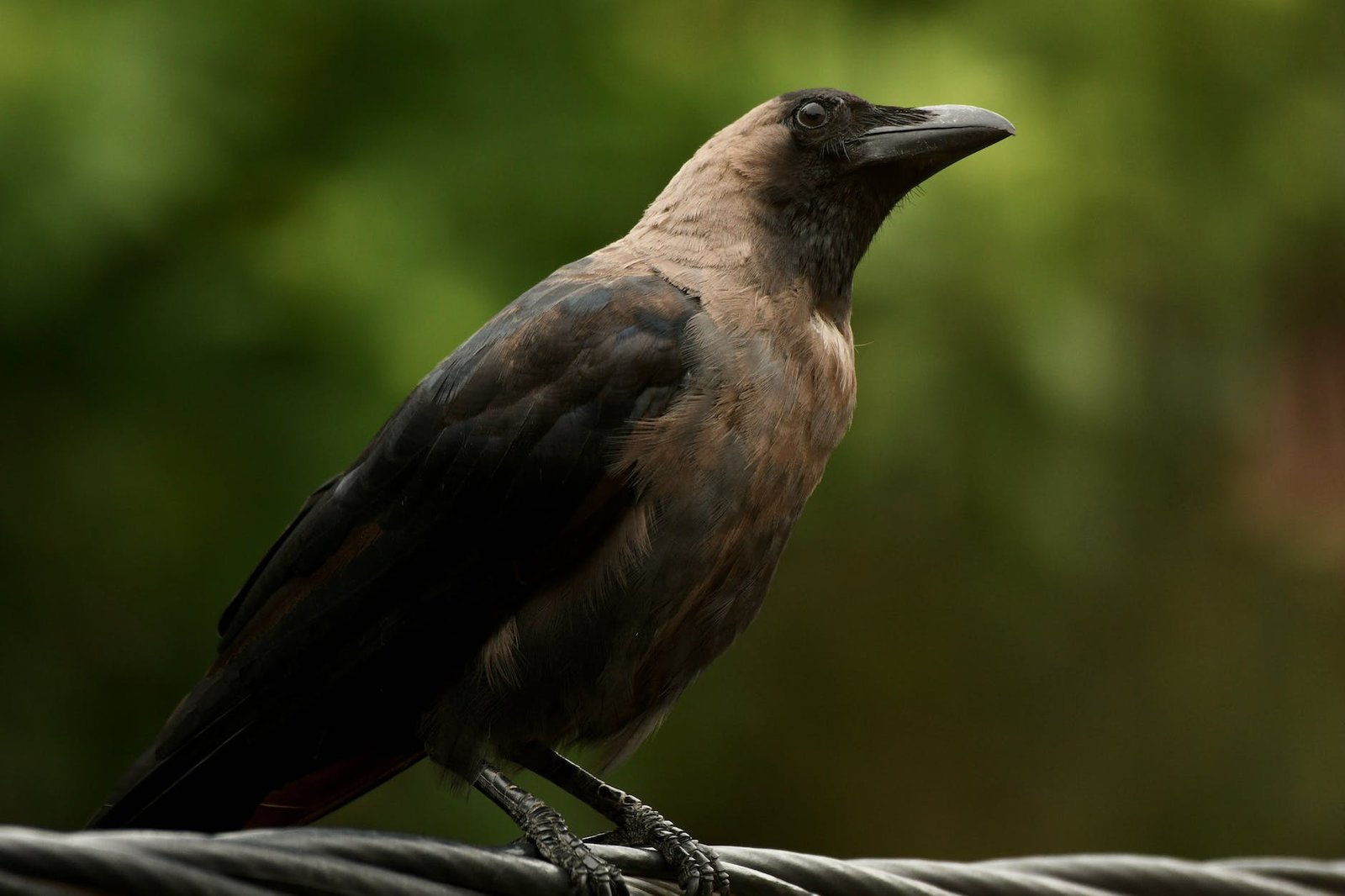Majestic and Mysterious: Exploring the Thick-Billed Raven of Ethiopia
December 29, 2023 | by BlackCrow.com

Introduction to the Thick-Billed Raven
The Thick-Billed Raven (Corvus crassirostris Rüppell, 1836) is a fascinating and majestic species of bird that is native to Ethiopia. Known for its distinctive features and unique behaviors, the Thick-Billed Raven has captured the curiosity of bird enthusiasts and researchers alike.
Overview of the Thick-Billed Raven
The Thick-Billed Raven is a large corvid bird, belonging to the same family as crows and ravens. It is recognized for its robust build and impressive size, making it one of the largest passerine birds in Africa. With an average length of 64 centimeters (25 inches) and a wingspan of approximately 115 centimeters (45 inches), the Thick-Billed Raven commands attention with its presence.
Unique Characteristics of the Species
What sets the Thick-Billed Raven apart from other corvids is its distinctive physical features. As the name suggests, this species possesses a thick, strong bill that is well-adapted for its feeding habits. The bill is not only powerful but also slightly curved, allowing the bird to access various food sources in its environment.
The plumage of the Thick-Billed Raven is predominantly black, with a glossy sheen that adds to its allure. Its feathers are sleek and well-groomed, contributing to its majestic appearance. The bird’s legs and feet are stout and strong, equipped for perching and maneuvering in its natural habitat.
Another remarkable characteristic of the Thick-Billed Raven is its intelligence and problem-solving abilities. Like other members of the corvid family, it demonstrates remarkable cognitive skills, including tool use and problem-solving capabilities. These traits contribute to its adaptability and success in its natural environment.
As we delve deeper into the world of the Thick-Billed Raven, we will explore its habitat, distribution, physical features, behavior, diet, conservation status, and fascinating facts. By gaining a comprehensive understanding of this captivating bird, we can appreciate the role it plays in the ecosystem and its significance in Ethiopian biodiversity.
Habitat and Distribution
The thick-billed raven, scientifically known as Corvus crassirostris Rüppell, 1836, is a majestic bird species found in the beautiful landscapes of Ethiopia. Let’s explore the natural habitat and distribution range of this remarkable bird.
Natural Habitat of the Thick-Billed Raven
The thick-billed raven is endemic to the highlands of Ethiopia, specifically the Ethiopian Plateau. Within this region, it occupies a variety of habitats including rugged mountains, rocky outcrops, and high-altitude grasslands. These habitats provide the thick-billed raven with the ideal conditions to thrive and showcase its unique behaviors.
Distribution Range and Population
The distribution range of the thick-billed raven is limited to Ethiopia, making it a special and sought-after bird for birdwatchers and nature enthusiasts visiting the country. Within Ethiopia, it is primarily found in the northern and central parts of the country, including the Semien Mountains, Bale Mountains, and Simien Mountains National Park.
As for the population of the thick-billed raven, it is difficult to estimate due to the bird’s elusive nature and the vastness of its habitat. However, it is believed that the population is relatively stable within its range. Further research and conservation efforts are necessary to gain a more comprehensive understanding of the population dynamics and ensure the long-term survival of this remarkable species.
By understanding the natural habitat and distribution range of the thick-billed raven, we can appreciate the importance of preserving its unique environment and ensuring the conservation of this majestic bird. To learn more about other fascinating crow species, such as the pied crow or the white-necked raven, continue exploring our blog.
Physical Features
The Thick-Billed Raven (Corvus crassirostris Rüppell, 1836) of Ethiopia possesses distinct physical characteristics that set it apart from other corvid species.
Size and Appearance
The Thick-Billed Raven is a large bird, measuring approximately 58-64 centimeters (23-25 inches) in length. It has a wingspan of around 110-130 centimeters (43-51 inches). With its robust build, the Thick-Billed Raven is one of the largest members of the crow family.
This raven species is predominantly black, with glossy feathers that reflect light in certain angles. The plumage is dense and provides insulation in the varying climates of its habitat. The bird’s bill is thick and heavy, giving it its distinctive name. It is characterized by a strong, arched upper mandible and a slightly curved lower mandible.
Notable Features of the Thick-Billed Raven
The Thick-Billed Raven possesses several notable features that contribute to its unique appearance and adaptability:
- Thick Bill: As the name suggests, the Thick-Billed Raven’s bill is one of its most prominent features. The robust bill allows the bird to handle a variety of foods, including tough carrion, fruits, and seeds.
- Thick Neck Hackles: The bird has conspicuous hackles on its neck, which are elongated feathers that give the appearance of a thick collar. These hackles can be raised or lowered, depending on the bird’s behavior and communication needs.
- Long, Tapered Tail: The Thick-Billed Raven has a long, wedge-shaped tail that aids in flight maneuverability. The tail feathers are pointed and can be spread or fanned out during certain displays or interactions.
- Strong Feet and Claws: The raven’s feet are large and powerful, equipped with strong claws. This adaptation allows the bird to perch securely and handle its prey effectively.
The physical features of the Thick-Billed Raven make it an impressive and majestic bird, well-suited to its natural habitat in the highlands of Ethiopia. Understanding its appearance is essential for recognizing and appreciating this remarkable corvid species.
Behavior and Diet
Understanding the behavior and diet of the Thick-Billed Raven provides insights into the fascinating lives of these majestic birds.
Social Behavior and Communication
Thick-Billed Ravens are highly social birds that typically form small family groups or large communal roosts. Within these groups, they exhibit complex social behaviors and maintain strong bonds. They communicate through a variety of vocalizations, including croaking calls, rattling sounds, and high-pitched whistles. These vocalizations play a crucial role in establishing territories, coordinating group movements, and expressing aggression or alarm. Ravens are also known for their playful behavior, engaging in aerial acrobatics and games with other members of their group.
Feeding Habits and Diet of the Thick-Billed Raven
Thick-Billed Ravens are opportunistic omnivores, meaning they have a diverse diet that includes both plant and animal matter. They are often seen scavenging for carrion, making them important contributors to the ecosystem by helping to clean up carcasses. In addition to carrion, they also feed on a variety of invertebrates, such as insects, spiders, and scorpions. These resourceful birds are known to crack open nuts and seeds using their powerful beaks. They may also consume fruits, berries, and other plant materials when available.
To represent the feeding habits of the Thick-Billed Raven, here’s a table showcasing their diet:
| Food Source | Percentage of Diet |
|---|---|
| Carrion | 40% |
| Invertebrates | 30% |
| Nuts and Seeds | 20% |
| Fruits and Berries | 10% |
It’s important to note that the diet of the Thick-Billed Raven may vary depending on the availability of food sources in their habitat. The ability to adapt their diet allows them to survive in diverse environments.
Understanding the behavior and feeding habits of the Thick-Billed Raven contributes to our appreciation of this remarkable species. The social interactions and dietary preferences of these birds highlight their unique place in the avian world.
Conservation Status and Threats
Understanding the conservation status and threats faced by the Thick-Billed Raven is crucial for ensuring its long-term survival. This section explores the current conservation status of the species and the primary threats that pose risks to its population.
Current Conservation Status
The Thick-Billed Raven (Corvus crassirostris) is classified as Near Threatened on the IUCN Red List of Threatened Species. This designation indicates that the species is at risk of becoming vulnerable to extinction if conservation efforts are not implemented effectively. The population of the Thick-Billed Raven is estimated to be relatively stable, but further research is needed to assess its true status and population trends accurately.
Threats to the Thick-Billed Raven Population
Several factors contribute to the threats faced by the Thick-Billed Raven population:
- Habitat Loss and Degradation: The conversion of natural habitats to agricultural lands, urbanization, and infrastructure development have resulted in significant habitat loss for the Thick-Billed Raven. This loss limits the availability of suitable nesting and foraging sites.
- Human Disturbance: Increasing human activities, such as tourism and recreation, can disrupt the nesting and foraging behaviors of the Thick-Billed Raven. Disturbances, including habitat encroachment and direct human interaction, can have detrimental effects on the species’ breeding success and overall population.
- Poaching and Collection: The Thick-Billed Raven faces threats from illegal poaching and collection for the exotic bird trade. These activities, driven by demand for live birds or their body parts, can severely impact the population if not adequately regulated and controlled.
- Climate Change: The changing climate patterns, including temperature increases and altered precipitation patterns, pose challenges for the Thick-Billed Raven. These changes can impact the availability of food resources, alter suitable habitat conditions, and disrupt breeding cycles.
- Invasive Species: The introduction of invasive species, such as predators or competitors, can have significant impacts on the Thick-Billed Raven population. These invasive species may outcompete the ravens for food resources or prey on their eggs and nestlings, leading to population declines.
Efforts are being made to mitigate these threats and conserve the Thick-Billed Raven population. Conservation organizations, researchers, and local communities are working together to raise awareness, establish protected areas, implement sustainable land-use practices, and monitor the population dynamics of the species.
By understanding the current conservation status and addressing the threats faced by the Thick-Billed Raven, we can ensure the continued existence of this majestic and mysterious bird in the Ethiopian landscape.
Fascinating Facts about the Thick-Billed Raven
The thick-billed raven, also known as Corvus crassirostris Rüppell, 1836, is a majestic and mysterious bird found in Ethiopia. In this section, we will explore some interesting behaviors, adaptations, as well as the cultural significance and mythology surrounding this unique species.
Interesting Behaviors and Adaptations
The thick-billed raven exhibits a range of fascinating behaviors and adaptations that contribute to its survival and success in its natural habitat. Here are a few noteworthy characteristics:
- Intelligence and Problem-Solving Skills: The thick-billed raven is known for its high level of intelligence and problem-solving abilities. It has been observed using tools, such as sticks or rocks, to extract food or gain access to hard-to-reach areas. This cognitive flexibility sets it apart from other bird species.
- Social Behavior: These birds are highly social and often form large groups or colonies. They engage in complex social interactions and communicate through a variety of vocalizations, including calls, croaks, and clucks. Additionally, they exhibit cooperative breeding, where multiple individuals help in raising the young.
- Adaptation to Harsh Environments: The thick-billed raven has adapted to survive in the rugged and mountainous regions of Ethiopia. Its strong bill is specially designed to handle tough food sources, such as carrion and hard-shelled fruits. Additionally, it has thick plumage that provides insulation against the cold temperatures at high altitudes.
Cultural Significance and Mythology
The thick-billed raven holds cultural significance and plays a role in the mythology of the Ethiopian people. It is often associated with wisdom, intelligence, and spiritual beliefs. Its distinctive call is believed to carry messages from ancestors or supernatural beings.
The bird’s presence in traditional stories, proverbs, and rituals reflects the deep respect and reverence that Ethiopian cultures have for this remarkable species. Its unique characteristics and behaviors have inspired artistic representations and have become symbols of wisdom and strength.
While the thick-billed raven’s cultural significance varies among different regions and communities in Ethiopia, its place in Ethiopian folklore highlights the deep connection between nature and human culture.
The fascinating behaviors, adaptations, and cultural significance of the thick-billed raven make it a captivating subject of study and admiration. As we continue to learn more about this majestic bird, we gain a deeper understanding of the intricate relationship between humans and the natural world.
Remember to visit our blog for more captivating articles about various crow species, such as the pied crow, white-necked raven, American crow, and many more.
RELATED POSTS
View all


